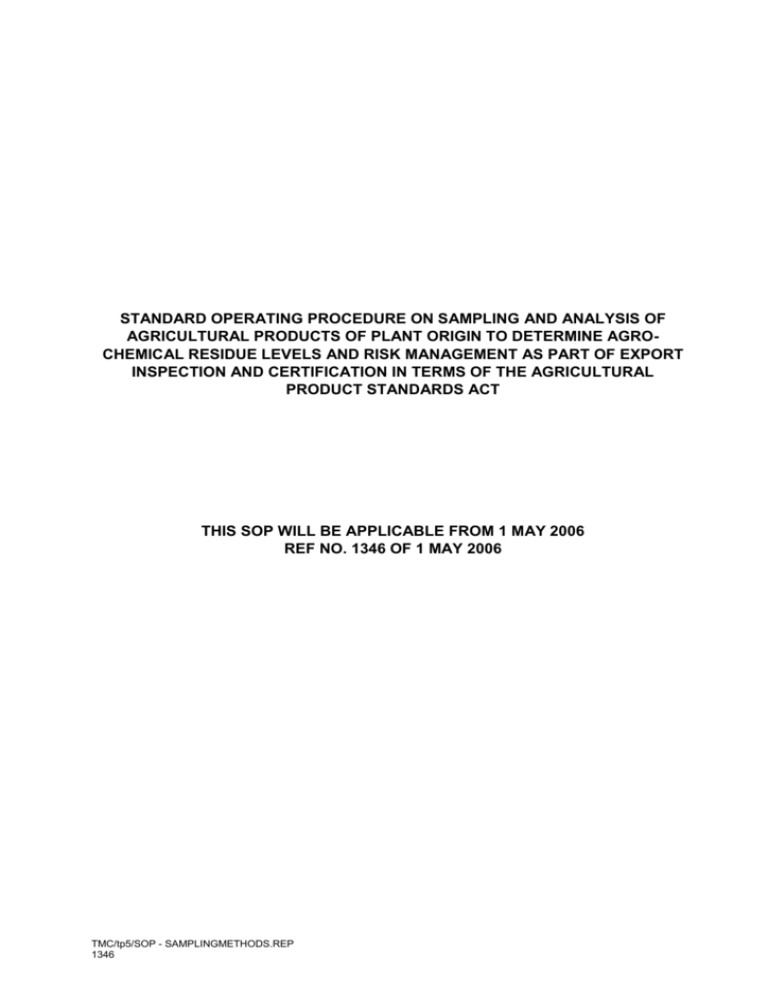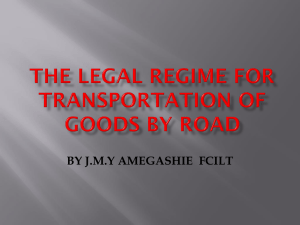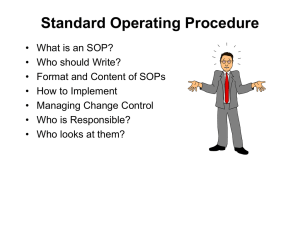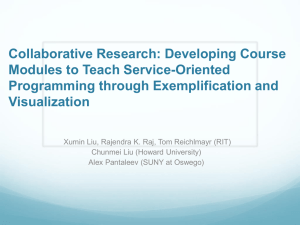Standard operating procedure
advertisement

STANDARD OPERATING PROCEDURE ON SAMPLING AND ANALYSIS OF AGRICULTURAL PRODUCTS OF PLANT ORIGIN TO DETERMINE AGROCHEMICAL RESIDUE LEVELS AND RISK MANAGEMENT AS PART OF EXPORT INSPECTION AND CERTIFICATION IN TERMS OF THE AGRICULTURAL PRODUCT STANDARDS ACT THIS SOP WILL BE APPLICABLE FROM 1 MAY 2006 REF NO. 1346 OF 1 MAY 2006 TMC/tp5/SOP - SAMPLINGMETHODS.REP 1346 INDEX Page 1. OBJECTIVE .......................................................................................................... 2 2. SCOPE ................................................................................................................. 2 3. DEFINITIONS ....................................................................................................... 2 4. REFERENCE TO REGULATORY REQUIREMENTS AND OTHER INTERNATIONAL DOCUMENTS .................................................................................... 5 5. ROLE-PLAYERS, ROLES AND RESPONSIBILITIES .......................................... 6 6. PRESCRIBED SAMPLING FREQUENCY ............................................................ 9 7. SAMPLING PROCEDURES FOR REPRESENTATIVE SAMPLING OF CONSIGNMENTS ......................................................................................................... 12 8. HANDLING AND DISPATCHING OF SAMPLES ............................................... 16 9. RECORD KEEPING OF SAMPLES.................................................................... 17 10. ANALYSIS .......................................................................................................... 18 11. REPORTING OF RESULTS AND STATISTICAL DATA .................................... 18 12. EVALUATION OF COMPLIANCE....................................................................... 19 13. HANDLING PROCEDURES FOR CONSIGNMENTS (A) EXCEEDING THE PRESCRIBED EXPORT MRL'S, AND (B) ON WHICH AGRO-CHEMICALS HAVE BEEN FOUND WHICH ARE NOT REGISTERED IN TERMS OF ACT 36 OF 1947 ..... 19 14. APPEAL PROCEDURES .................................................................................... 24 15. HANDLING OF COMPLAINTS FROM IMPORTING COUNTRIES (NON- CONFORMITIES) .......................................................................................................... 25 16. ANNEXURES ..................................................................................................... 28 17. CONTRACT REVIEW ......................................................................................... 28 18. RECORDS .......................................................................................................... 28 TMC/tp5/SOP - SAMPLINGMETHODS.REP 1346 2 1. OBJECTIVE To manage the sanitary risk (food safety) of regulated agricultural products of plant origin intended for export by auditing compliance with maximum agrochemical residue levels based on importing countries requirements, export default lists compiled by National Department of Agriculture (DoA)and Regulation R707 of 13 May 2005. 2. SCOPE The Standard Operating Procedure (SOP) shall be followed by all personnel of the DoA and relevant assignees involved in the auditing of compliance of agrochemical residues permitted in or on regulated agricultural products of plant origin presented for export inspection and certification. The SOP shall include procedures for sampling, handling, analysis, dissemination of results, evaluation of compliance, traceability and follow-up of non-compliance, recall and risk communication to all relevant role-players and stakeholders. 3. DEFINITIONS Where used with regard to sampling and analysis -- 3.1 "agro-chemical residue": the residues of pesticides (insecticides, herbicides and fungicides) and include banned or restricted substances; 3.2 "assignee": a person, undertaking, body, institution, association or board designated under section 2(3) of the Agricultural Product Standards Act, 1990 (Act No. 119 of 1990); 3.3 "bulk sample/aggregate sample" (also referred to as the "inspection sample" in the export standards and requirements): the combined and well-mixed aggregate of the primary samples taken from a consignment; TMC/tp5/SOP - SAMPLINGMETHODS.REP 1346 3 Note: (a) The primary samples must contribute sufficient material to enable all laboratory samples to be withdrawn from the bulk sample. (b) Where separate laboratory samples are prepared during collection of the primary sample(s), the bulk sample is the conceptual sum of the laboratory samples, at the time of taking the samples from the consignment. 3.4 "consignment": a quantity of a specific agricultural product of plant origin which -- (a) belongs to the same owner, delivered at the same time under cover of the same delivery note, consignment note or receipt note, or delivered by the same vehicle; or (b) if subdivided into different cultivars, classes, sub-classes, grades, types, counts, count groups, type groups, size groups, colour groups, diameter groups, production groups, diameter codes, size codes, production lots, pallet loads, trade marks, packaging sizes or types of packaging in every quantity of each of the different cultivars, classes, sub-classes, grades, types, counts, count groups, type groups, size groups, colour groups, diameter groups, production groups, diameter codes, size codes, production lots, pallet loads, trade marks, packaging sizes or types of packaging; 3.5 "Executive Officer": the officer designated under section 2(1) of the Agricultural Product Standards Act, 1990 (Act No. 119 of 1990); 3.6 "inspector/assessor": the Executive Officer or an officer under his or her control, or an assignee or an employee of an assignee. For the purpose of this document sampling officer refer to inspector or assessor responsible to take the sample; 3.7 "laboratory sample": the sample sent to, or received by, the laboratory and which shall consist of a representative quantity of material removed from the bulk sample; TMC/tp5/SOP - SAMPLINGMETHODS.REP 1346 4 Notes: 3.8 (a) The laboratory sample may be the whole or a part of the bulk sample. (b) Units should not be cut or broken to produce the laboratory sample(s). (c) Replicate laboratory samples may be prepared. "maximum residue limit (MRL)": the maximum concentration of a pesticide residue (expressed as mg/kg) legally permitted in or on agricultural products of plant origin; 3.9 "primary sample/incremental sample" (also referred to as the "sample of the consignment" in the export standards and requirements): a volume or mass or one or more units taken from one position in a consignment; Notes: (a) The position from which a primary sample is taken in the consignment should preferably be chosen randomly but, where this is physically impractical, it should be from a random position in the accessible parts of the consignment. (b) The number of units required for a primary sample should be determined by the minimum size and number of laboratory samples required. (c) Where more than one primary sample is taken from a consignment, each should contribute an approximately similar proportion to the bulk sample. (d) Units should not be cut or broken to produce the primary sample(s). (e) Where primary samples are taken at intervals during loading or unloading of a consignment, the sampling 'position' is a point in time. 3.10 "Food Business Operator (FBO)": the person or persons responsible for ensuring that the prescribed requirements of these standards are met within the food business under his or her control and include both the management of the food business as well as the person with overall authority on site or in the specific establishment; 3.11 "Food Business Operator Code (FBO)": an alpha-numeric code which has been registered with the Executive Officer of the APS Act by each producer, packhouse packing fruit and vegetables and all other FBO's destined for export; TMC/tp5/SOP - SAMPLINGMETHODS.REP 1346 5 3.12 "sample": one or more units selected from a population of units, or a portion of material selected from a larger quantity of material. For the purposes of these recommendations, a representative sample is intended to be representative of the consignment, the bulk sample, etc., in respect of its agro-chemical residue content and not necessarily in respect of other attributes; 3.13 "sampling": the procedure used to draw and constitute a sample; 3.14 "sampling device": a tool prescribed by legislation in terms of the Agricultural Product Standards Act, 1990 (Act No. 119 of 1990). 3.15 "sample size": the number of units, or quantity of material, constituting the sample; and 3.16 "unit": the smallest portion in a lot, which should be withdrawn to form the whole or part of a primary sample. Notes: (a) Fresh fruit and vegetables - Each whole fruit, vegetable or natural bunch (e.g. grapes) should form a unit. Individual fresh fruit or vegetables must not be cut or broken to produce units. (b) Packaged materials - The smallest entity of packaging should be taken as units. Where the smallest packages are very large, they should be sampled as bulk, as set out in paragraph (c). Where the smallest packages are very small, a pack of packages may form the unit. (c) Bulk materials and large packages (such as drums, bags, etc.) which are individually too large to be taken as primary samples - The units are created with a sampling device. 4. REFERENCE TO REGULATORY REQUIREMENTS AND OTHER INTERNATIONAL DOCUMENTS 4.1 All relevant current S.A. Directives and export standards shall be adhered to at all times. 4.2 All relevant and current EU Directives and Codex Alimentarius Standards shall be adhered to at all times. TMC/tp5/SOP - SAMPLINGMETHODS.REP 1346 6 5. ROLE-PLAYERS, ROLES AND RESPONSIBILITIES 5.1 Appointed Assignee Assessor or Inspector of the appointed assignee is responsible for executing the following actions: (a) Taking at random a representative sample from the consignment concerned and in accordance with the prescribed sampling procedure. (Refer to page 15). (b) Completing the inventory list and forwarding it in the agreed standard electronic format via e-mail to the laboratory concerned. Faxes as well as/or a courier with samples on arrangement with the DoA Laboratories, will be accepted. (c) Completing the correct label sticker with information specific to the sample concerned and attaching it to each plastic bag that contains the sample as indicated in Annexure B. (d) Dispatching the samples to the laboratory. (As prescribed in Section 8). (e) Once final analysis results are received from the laboratory, the assignee will interpret and forward the final results to the producer or packhouse and/or exporter on request. (f) Taking the necessary actions if the MRL's are exceeded. (Refer to section 13 Recall Procedure). (g) Taking of further samples if and when required in accordance to sampling procedure. TMC/tp5/SOP - SAMPLINGMETHODS.REP 1346 7 5.2 Laboratories (a) Analysis for agro-chemical residues will be done either at the Department of Agriculture's laboratory in Pretoria (Agriculture Place, 20 Beatrix Street, Arcadia, Pretoria, Tel.: (012) 319-6089 or at Stellenbosch (Quarantine Station, Polkadraai Road, Tel.: (021) 809-1728). (b) The two DoA laboratories concerned are responsible for analysing samples drawn by the relevant assignee. (c) The laboratories are responsible for executing the following actions: (i) Receiving of the samples forwarded by the appointed assignee and entering the details in a logbook. Relevant DoA Laboratory must confirm receival of samples within 24 hours per logsheet). (ii) Analysis of the laboratory samples in accordance with the Quality Assurance procedure. (iii) Forwarding the final analysis results in the agreed standard electronic format to the appointed assignee and within the agreed time from receipt, i.e. 4 working days. (iv) Review the test profile annually with the relevant producer group. (v) Liaise internationally with regard to analytical methodology. PLEASE NOTE: Samples are received, analysed and reported by the laboratory as prescribed by the Quality Assurance System of the specific laboratory that is in compliance with the ISO/IEC 17025 standard namely, "General requirements for the competence of testing and calibration laboratories". TMC/tp5/SOP - SAMPLINGMETHODS.REP 1346 8 5.3 Subdirectorate: Agricultural Product Quality Assurance (a) To continuously update the internal Quality Control library with hard copies of the importing countries latest MRL data, if available. (b) Update lists, where relevant, with the latest MRL's after consultation and inputs of the relevant industries and agro-chemical companies. (c) The divisional head of each division within the Subdirectorate: Agricultural Product Quality Assurance should provide both the laboratories as well as the appointed assignee with the latest MRL export lists for each agricultural product of plant origin destined for export. (In the case of fresh fruit, such information should be provided at least two months in advance of the start of the harvesting season for the fruit concerned.). The list of MRL values will be used as standards by the laboratories as a guide to decide on additional tests for confirmation of test results. (d) Liaise nationally with regard to any enquiries received from producers, packers or exporters on the analysis results of samples. (e) Liaise internationally -- (i) to clarify the policy, status of an agro-chemical or MRL in an importing country; and (ii) (f) with regard to non-conformities. Issuing of official residue certification when requested on special requirements from importing Governments. 5.4 Exporters (a) To ensure that export produce complies with MRL requirements of importing countries and to provide producers with relevant importing country MRL requirements. TMC/tp5/SOP - SAMPLINGMETHODS.REP 1346 9 (b) To inform the Directorate: Food Safety and Quality Assurance (D: FSQA) of the Department of Agriculture (DoA) in writing, within 3 working days after being informed, of any rejections by importing country authorities due to residues and to furnish the following information: (c) (i) Name of importing country. (ii) Reason for rejection (iii) Contact details of exporter. (iv) Details on specific consignment. (v) Export certificate number. To recall, destroy or re-route consignments should residue results indicate non-compliance as per item 13. 5.5 Producers, packers and handlers (a) Apply registered agro-chemicals according to manufacturer instructions regarding application, dosages and withholding periods, etc. (b) Keep record of the agro-chemicals (including dosages and withholding periods) used in spray programs and as post harvest treatment and to provide this information on request to the D: FSQA of DoA. 6. PRESCRIBED SAMPLING FREQUENCY 6.1 General (a) Sampling shall only be done under direct supervision of an inspector. TMC/tp5/SOP - SAMPLINGMETHODS.REP 1346 10 (b) Only consignments presented for export shall be sampled for agro-chemical residue testing. (c) Bulk samples of a product shall -- (i) in the case of fresh fruit and vegetables, be withdrawn in such a way that it is possible to trace it back to a PUC-FBO code, and as far as possible be distributed to include different cultivars; or (ii) in the case of other products, be withdrawn in such a way that it is possible to trace it back to the lowest level of traceability of the consignment presented for inspection (e.g. silo bin, processing plant, producer, owner, exporter). 6.2 Initial sampling (a) At the start of the season sampling will be done randomly for each product, area and consignments presented for export, taking into account the capacity of the lab. (b) Sampling priorities will be further adapted according to the following risk status: (i) Non conforming FBO's of the current or previous seasons will be seen as the first priority for sampling. (ii) FBO's not monitored will be the second priority. (iii) Commodity/variety specific to FBO will be treated as the third priority. (iv) The last priority will be ad hoc sampling i.e. specific regions/product group. TMC/tp5/SOP - SAMPLINGMETHODS.REP 1346 11 6.3 Further sampling in the case of non-compliance of initial sampling (a) If the analysis results of the initial sampling indicate that one or more of the agro-chemical residues found exceed the maximum residue levels, the sampling frequency shall be tightened/increased to include at least two follow-on consignments presented for inspection. (b) Only if the analysis results of at least two consecutive consignments sampled in paragraph (a) above indicate that the agro-chemical residues found are within the maximum residue levels, may the sampling frequency be reduced to a monitoring level depending on laboratory capacity. 6.4 Schematic representation of sampling frequency START Sample consignment presented for export inspection Risk status of PUCspecific product Risk status of PUC (all products) One of last 2 samples > MRL > One of last 2 samples > MRL YES Sample for residue analysis Laboratory capacity available Risk status of area / product / destination country etc. (MANUAL ADJUSTING) NO HIGH RISK Update PUC sampling records. END LOW RISK # of consecutive samples not sampled = maximum Risk status of PUC with regard to sampling history TMC/tp5/SOP - SAMPLINGMETHODS.REP 1346 Laboratory Results < Maximum sampled 12 7. SAMPLING PROCEDURES FOR REPRESENTATIVE SAMPLING OF CONSIGNMENTS 7.1 Precautions to be taken (a) During sampling of agricultural plant products for analytical purposes, every precaution should be taken to prevent contamination and deterioration of the samples or subjecting the samples to such changes that the residue content thereof is affected. (See item 8.1 on the "Handling and Dispatching of Samples".) (b) Each laboratory sample sent to the laboratory shall represent a consignment. 7.2 Collection of primary samples ("sample of the consignment") (a) Each primary sample should be taken from a randomly chosen position in the consignment, as far as practically possible. (b) The primary samples should consist of sufficient material to provide the laboratory sample(s) required. (c) The minimum number of primary samples to be taken from the consignment shall be as follows in cases where -- (i) plant products, either packaged or in bulk, can be assumed to be well mixed or homogeneous: 1 (one) primary sample Note: [A consignment may be mixed by e.g. grading or manufacturing processes]. TMC/tp5/SOP - SAMPLINGMETHODS.REP 1346 13 (ii) plant products, either packaged or in bulk, are not well mixed or homogeneous: (aa) The total weight of the consignment is known: Weight of the Minimum number of primary samples to consignment (kg) be taken from the consignment < 50 kg 3 50 - 500 kg 5 > 500 kg 10 (bb) The total number of containers (cans, cartons or other types of containers) in the consignment is known: Number of containers in Minimum number of primary samples to the consignment be taken from the consignment 1 - 25 1 26 - 100 5 > 100 10 Note: For products comprised of large units, being commodities of plant origin only, the minimum number of primary samples should comply with the minimum number of units required for the laboratory sample as set out in item 7.4(c). 7.3 Preparation of the bulk sample ("inspection sample") (a) The primary samples should be combined and/or mixed well, if practically possible, to form the bulk sample. 7.4 Preparation of the laboratory samples (a) Laboratory samples should be taken randomly from the bulk sample. (b) Where the bulk sample is larger than is required for a laboratory sample, it should be divided to provide a representative portion. A sampling device, TMC/tp5/SOP - SAMPLINGMETHODS.REP 1346 14 quartering, or other appropriate size reduction process may be used but units of fresh plant products should not be cut or broken. Where required, replicate laboratory samples should be withdrawn at this stage or it may be prepared using the alternative procedure (sampling device, quartering, etc.) described above. (c) The minimum size required for laboratory samples is as follows: PRODUCT 1. NATURE OF PRIMARY SAMPLES TO BE TAKEN MINIMUM SIZE OF EACH LABORATORY SAMPLE Fresh products of plant origin (a) (b) 2. EXAMPLES All fresh fruit and vegetables (i) Small (<25 g) Peas Whole units, or packages, or units taken with a sampling device 1 kg (ii) Medium (25250 g) Apples, oranges Whole units 1 kg (at least 10 units) (iii) Large (>250 g) Cabbage, cucumbers, grapes (bunches) Whole unit(s) 2 kg (at least 5 units) Pulses Dried beans, dried peas 1 kg Cereal grains Wheat 1 kg Oilseeds Peanuts 0,5 kg Processed products of plant origin (a) Products of high unit value As determined from time to time by the Executive Officer Packages or units taken with a sampling device 0,1 kg* (b) Solid products of low bulk Rooibos Packaged units or units taken with a sampling device 0,2 kg (c) Other solid products Bread, flour, dried fruit Packages or other whole units, or units taken with a sampling device 0,5 kg (d) Liquid products Fruit juices, pulp and puree Packaged units or units taken with a sampling device 0,5 litre or 0,5 kg Note: * A smaller laboratory sample may be taken from a product of exceptionally high value: Provided that the reason(s) for doing so should be noted in the sampling record. TMC/tp5/SOP - SAMPLINGMETHODS.REP 1346 15 7.5 Schematic representation SCHEMATIC REPRESENTATION OF SAMPLING PROCEDURES Consignment and primary samples 3,5 and 10 primary samples taken from the same randomly chosen positions ■ ■ ■ ■ ■ ■ ■ ■ ■ ■ ■ ■ ■ ■ ■ Note: Primary samples are combined to form the bulk sample Units comprising the bulk sample Note: Where laboratory samples are prepared directly from the consignment, the bulk sample is the conceptual sum of the laboratory samples Laboratory sample (1 or more) TMC/tp5/SOP - SAMPLINGMETHODS.REP 1346 Parts not to be analysed Partly-prepared analytical sample Fully-prepared analytical sample Analytical portion (1 or more) 16 8. HANDLING AND DISPATCHING OF SAMPLES 8.1 General (a) The person responsible for taking the samples should always where possible use clean hands prior to sampling. (b) Samples must be handled as little as possible and should be placed as soon as possible in the plastic bags or containers in which it will be dispatched. (c) All samples should be placed in clean plastic bags (provided by the laboratories) which are large and strong enough to ensure that the samples are delivered intact to the laboratory. A hard copy of the inventory must be included in the container. Care should be taken not to overfill the plastic bags. (d) Plastic bags or containers in which samples are placed should be sealed to prevent contamination from the outside. Each plastic bag should be folded down repeatedly to remove the air inside as far as possible and should be stapled on the folds. (e) To prevent damaging of the fruit or plastic bags, not too many samples should be dispatched in the same outer container. (f) Samples shall not be exposed to high temperatures and should, where possible, be stored under refrigeration or at least in a cool place before being dispatched to the laboratory. (g) Samples must reach the laboratory in a good condition within 2 working days after sampling. (h) Samples shall be stored out of direct sunlight at the laboratories. TMC/tp5/SOP - SAMPLINGMETHODS.REP 1346 17 8.2 Urgent samples (a) Only samples from consignments that have been held back from export awaiting the analysis results may be marked with red "Urgent" stickers. Only in exceptional cases and only if prior arrangements have been made with the laboratory may other samples be marked as such. (b) Samples with red "Urgent" stickers will get preferential treatment if a signed motivation is given by the assignee's area manager. (c) The analysis results of samples marked as "Urgent" and which have been delivered to the laboratory before 10:00 shall be made available in 2 working days. 9. RECORD KEEPING OF SAMPLES 9.1 Sampling record (a) An inventory list (see Annexure A as an example) of all the samples that are packed in an outer container and is sent to the laboratory shall be placed inside the outer container and not inside the plastic bags. The inventory list shall also be forwarded in the agreed standard electronic format via e-mail to the laboratory concerned and shall reach the laboratory within two working days after the samples have been dispatched. The information included in this inventory is copied directly into the database of the laboratory concerned. (b) Each container dispatched to the laboratory shall be placed on a separate inventory list to enable laboratory personnel to verify that all samples actually arrived at its destination. (The lab will acknowledge receipt of the samples as per inventory list.) TMC/tp5/SOP - SAMPLINGMETHODS.REP 1346 18 (c) Each inventory list should be given a unique number in the following format: "Inventory AC-nnn" where AC = area code; and nnn = serial number (d) The laboratories shall provide stickers (see Annexure B as an example) which have to be completed for each sample and which must be attached to the outside of each plastic bag. 10. ANALYSIS Analysis is done according to ISO 17025 Standard. PLEASE NOTE: Samples are received, analysed and reported by the laboratory as prescribed by the Quality Assurance System of the specific laboratory that is in compliance with the ISO/IEC 17025 standard namely, "General requirements for the competence of testing and calibration laboratories". 11. REPORTING OF RESULTS AND STATISTICAL DATA 11.1 General (a) The final analysis results shall be forwarded electronically in the agreed standard electronic format via e-mail by the laboratories to the head office of the appointed assignee within 4 working days of receipt of the sample(s) and the relevant Divisional Head of APQA. TMC/tp5/SOP - SAMPLINGMETHODS.REP 1346 19 (b) A consolidated document of the analysis results, excluding any reference, will be forwarded at the end of every week by the laboratories to representative growers' associations where prior arrangements have been made. 12. EVALUATION OF COMPLIANCE 12.1 The appointed assignee shall compare the results with the MRL's lists supplied by APQA for each product to determine whether the product complies with the prescribed MRL's or not. 12.2 In the event, where an export default MRL is not provided for a given active ingredient on a specific product, it is the responsibility of the appointed assignee to liaise with the relevant policy division of the Subdirectorate: Agricultural Product Quality Assurance (APQA) of DoA. Such query should include the sample reference number and country(ies) of destination. Feedback on such queries must be done in writing, via e-mail or fax to the assignee within 24 hours. 12.3 The appointed assignee shall in the case of non-compliance follow the procedures set out in item 13. 13. HANDLING PROCEDURES FOR CONSIGNMENTS (A) EXCEEDING THE PRESCRIBED EXPORT MRL'S, AND (B) ON WHICH AGRO-CHEMICALS HAVE BEEN FOUND WHICH ARE NOT REGISTERED IN TERMS OF ACT 36 OF 1947 13.1 Consignments exceeding the prescribed export default MRL's Should the analysis results indicate that one or more of the agro-chemical residues found exceed the maximum residue limit, the procedures set out below shall be followed in the case of (a) non-shipped, and (b) shipped consignments respectively. TMC/tp5/SOP - SAMPLINGMETHODS.REP 1346 20 (a) Non-shipped consignments The consignment concerned shall either be (i) rejected by the appointed assignee, or (ii) re-routed by the exporter. (i) Rejected consignments (aa) The appointed assignee shall immediately notify the exporter/ producer/packer concerned. (bb) The appointed assignee shall also immediately notify the relevant laboratory and the relevant Divisions of the Directorates: APIS and FSQA of the Department of Agriculture. (cc) If the rejected consignment also exceeds the local MRL and is not re-routed, APIS shall then inform the following two Directorates in writing: (aaa) The Directorate: Food Control of the Department of Health. (bbb) The Directorate: Agricultural Production Inputs of the Department of Agriculture (Act 36). (ii) Re-routed consignments The procedure set out in item 13.1(b)(ii) shall be followed. (b) Shipped consignments Consignments of which the analysis results were received after being shipped must either be (i) recalled or destroyed, or (ii) re-routed to another country where the established MRL is acceptable. TMC/tp5/SOP - SAMPLINGMETHODS.REP 1346 21 (i) Recalled or destroyed consignments Exporters shall provide written proof to the appointed assignee as well as the Quality Auditing Divisions of the D: FSQA of DoA that consignments were recalled or destroyed. (ii) Consignments destined for re-routing (aa) Exporters wishing to re-route consignments to another country where the established MRL is acceptable, must supply proof to the appointed assignee as well as the D: FSQA of DoA thereof in writing. (bb) If the MRL of the importing country differs from the MRL prescribed by the D: FSQA of DoA or is not prescribed, the D: FSQA shall verify the MRL in question and provide the appointed assignee and exporter with a written permission or refusal. (cc) The exporter shall upon receipt of such permission submit an affidavit to the appointed assignee that certifies that the produce shall only be exported to the country/countries stated on the affidavit. (dd) Consignments may only be re-routed after the appointed assignee has acknowledged receipt of the completed affidavit and by approving (signing and stamping) the document. TMC/tp5/SOP - SAMPLINGMETHODS.REP 1346 22 (ee) Copies of the completed affidavit shall be kept by the exporter and the appointed assignee. (iii) Follow-on consignments (aa) Follow-on consignments of a producer whose consignment exceeded prescribed MRL's shall be held back from export for not more than 4 days in order to establish if it complies with the prescribed MRL's. (bb) If a consignment again exceeds any prescribed MRL's, the consignment will be rejected for export or re-routed as set out in item 13.1(b)(ii). (cc) In the case of compliance the consignment will be released for export. (dd) Consignments that exceeded the export as well as local MRL's must be dealt with in accordance with item 13.1(a)(i). TMC/tp5/SOP - SAMPLINGMETHODS.REP 1346 23 (c) Schematic representation FLOW CHART: HANDLING PROCEDURES FOR CONSIGNMENTS EXCEEDING THE PRESCRIBED EXPORT MRL’s NON-SHIPPED CONSIGNMENTS SHIPPED CONSIGNMENTS PPECB notifies exporter & issue rejection notice. Exporter has 3 options: Non-shipped consignments -automatically hold back from export Re-route Assignee notifies exporter/producer/ packer & QA Exporter has 2 options: Re-route Recall Destroy Exporter provides written proof to Assignee & QA Exporter establish country, notify & supply proof of acceptance to Assignee & DPHQ If mrl differs/ not appear on DPHQ prescripts – DPHQ verify & notify Assignee & exporter Sell on local market If not approved by DPHQ – Assignee reject consignment for export FOLLOW-ON CONSIGNMENTS If approved by DPHQ, exporter to submit completed affidavit to Assignee QA notifies Dir Food Control, DoH & API, NDA Hold back for max 4 days to establish compliance Exporter re-routes consignment/s upon receipt of Assignee's acknowledgement (receipt of affidavit). Name of the importing country(ies) must be indicated on relevant documentation If mrl exceeds local limit/substance is banned or not locally registered – it must be dealt with according to DoH & API (Act 36 of 1947) prescripts TMC/tp5/SOP - SAMPLINGMETHODS.REP 1346 Certified copies of affidavit filed by Assignee and exporter Comply – release for export Exceed Re-route Reject for export 24 13.2 Consignments on which agro-chemicals have been found which are not registered in terms of Act 36 of 1947 (a) In the event of a consignment on which an agro-chemical have been found which is not registered or which contains a banned or restricted substance, the procedures set out in item 13.1(a)(ii) and (iii) shall be followed. 14. APPEAL PROCEDURES 14.1 General (a) A producer or exporter may appeal against the results of the laboratory on the analysis of a sample analysed and MRL exceeded for the presence of agro-chemical residues. (b) The regulations regarding inspection and appeals as well as the prescribed appeal fees shall be applicable. (c) The selected appeal board shall, in the presence of the producer or exporter or their representative, withdraw a sample for analysis from the consignment in question according to sampling and handling procedures prescribed in this SOP. Refer to Codex Alimentarius procedures. (d) The analysis shall be done at the producer's or exporter's expense and shall be paid to the Executive Officer. (e) Prior arrangements shall be made with the laboratory to, amongst others -- (i) assure availability of information required; (ii) determine the costs involved; TMC/tp5/SOP - SAMPLINGMETHODS.REP 1346 25 (iii) ensure that the analysis results are also made available to the Appeal Board; and (iv) ensure that the account is send to the correct person/company and address. (e) A written affidavit shall be obtained by the Directorate: FSQA of DoA from the producer or exporter which shall indicate that he/she will be fully responsible for all costs involved in the dispatching and analysis of the sample and that he/she indemnifies the Department of Agriculture and Directorate: FSQA of DoA of any costs in this respect. (See Annexure C as an example of an affidavit). 15. HANDLING OF COMPLAINTS FROM IMPORTING COUNTRIES (NONCONFORMITIES) The APQA, appointed assignee and the laboratories will be copied in with this reports / results and FBO code must be stated. 15.1 General (a) The D: FSQA of DoA will acknowledge, in writing within 2 working days, receipt of a non-conformity from an importing country with regard to the exceeding of an MRL, or the use of unregistered agro-chemicals. (b) The D: FSQA of DoA will evaluate the information received within 2 working days of receipt of the non-conformity. (c) The relevant exporter/packhouse/producer and producer association, where applicable, will be notified by the D: FSQA of DoA within 3 working days of receipt of a non-conformity. TMC/tp5/SOP - SAMPLINGMETHODS.REP 1346 26 (d) Should the information mentioned in paragraph (b) not be sufficient, additional information must be requested in writing from one or more of the following role players involved: 15.2 (i) Importing country. (ii) Exporter. (iii) Packhouse. (iv) Producer. (v) Laboratories of the D: FSQA of DoA. Information from the importing country (a) Where sampling and analytical methods used by the importing country are in doubt, such methods shall be requested by the D: FSQA of DoA from the relevant authorities via the appropriate channels (Embassy) where necessary and must at least include -- (i) the method of sampling; (ii) the sample size; (iii) the manner in which the sample(s) was/were handled and treated throughout the process; and (iv) (b) the analytical test procedure. Detailed records of the analysis results will be requested where necessary for interpretation by laboratories of the D: FSQA of DoA. (c) 15.3 Information must be obtained in the shortest possible time. Information from exporters, packhouses and producers (a) The relevant exporter must, where possible, obtain and forward digital photos of all 4 sides of one carton in the consignment concerned to the D: FSQA of DoA within 3 working days of receiving a request in this regard. TMC/tp5/SOP - SAMPLINGMETHODS.REP 1346 27 (b) The relevant exporter/packhouse/producer must provide the following information on request: (i) Spray programs, including names of agro-chemicals sprayed, dosages, date of application, withholding periods and actual harvest dates. (Possibilty of drift). (ii) Phytotoxicity detected on trees or plants. (iii) Analytical results of private quality control samples with regard to the chemical/produce in question and the laboratory(ies) involved. (iv) An explanation why the MRL was exceeded or a specific agrochemical was used or any additional info that might be useful to the investigation. (c) The requested information must reach the D: FSQA of DoA within 3 working days. 15.4 Information from the laboratories of the Directorate: Food Safety and Quality Assurance of the Department of Agriculture (a) The D: FSQA of DoA will request, when necessary, statistics from the lab/s of the D: FSQA regarding the chemical/produce in question. (b) 15.5 Information must be provided within 3 working days. Actions to be taken by the Directorate: Food Safety and Quality Assurance of the Department of Agriculture The D: FSQA of DoA will, in conclusion – TMC/tp5/SOP - SAMPLINGMETHODS.REP 1346 28 (a) evaluate all information received/gathered (in collaboration with the Directorate: Agricultural Production Inputs of the Department of Agriculture if necessary) and decide on a course of action; (b) conduct risk communication either via press or only to the relevant industry association or exporter/packhouse/producer in instances where no organized industry association exists; and (c) provide feedback to the relevant authorities in the importing country of actions taken and/or the outcome of the investigation. 16. ANNEXURES The following Annexures are attached: (a) Annexure A - Example of an inventory list. (b) Annexure B - Example of sticker that must be attached to the outside of each plastic bag. 17. (c) Annexure C - Affidavit to be completed in case of appeals. (d) Annexure D - Contact person(s) from PPECB and DoA. CONTRACT REVIEW The SOP will be reviewed annually. 18. RECORDS All records as stated in this SOP shall be kept for a period of two years and in accordance of DoA archive procedure. TMC/tp5/SOP - SAMPLINGMETHODS.REP 1346 29 ANNEXURE A EXAMPLE OF AN INVENTORY LIST Area of Sample Origin Number Product Cultivar Consignment Exporter Inspection Date of Number Code Point Inspection Producer & PUC Analysis Required INVENTORY 47-35 47-35 4702G5126NWGA003 GROUNDNUTS 2BEBC167S534H5 NWG 5126 4-Sep-02 PESTICIDES 47-35 4702G5126NWGA002 GROUNDNUTS 2BEBC178S531H5 NWG 5126 4-Sep-02 PESTICIDES 47-35 4702GSWH5134R07 GROUNDNUTS BHVK 255 SWH 5134 4-Sep-02 PESTICIDES Total Samples forwarded on this dispatch 0 E-mail this to Mr Pieter Broere on pieterb@nda.agric.za each time a batch of samples are forwarded to the laboratory. TMC/tp5/SOP - SAMPLINGMETHODS.REP 1346 30 ANNEXURE B EXAMPLE OF STICKER WHICH MUST BE ATTACHED TO THE OUTSIDE OF EACH PLASTIC BAG Sent by: _____________ Area(code) ________ Exporter code: _______ Inspect. Point______ Product: _____________________ Cultivar: _________________ Sample number_________ PUC/FBO ___________ Producer_________________________ Insp. Date_______________ Sampler's name:______________ Consignm. No.:________ Remarks____________________ Analysis required: pesticide residues [ ] aflatoxin [ ] SO2 [ ] % moisture [ ] other__________ ____________________________________________________________________________ Explanatory Notes: 1. Sent by - Refers to the organisation sending the samples, e.g. PPECB, APIS. 2. Area - Refers to the regional office that the sampling point falls under. 3. Exporter code - Refers to the three letter codes used internally by PPECB to identify their exporters. 4. Insp point - Refers to the place where the sample was drawn. For PPECB a four-letter code is used. For all other samples the name of the town/city is used. 5. Product - Refers to the type of product sent, e.g. apples, grapes, raisins, etc. (not to be used to indicate the cultivar name). 6. Cultivar - Refers to the name of the specific cultivar of a product. 7. Sample number - Refers to a unique and individual number allocated to each sample. (PPECB would for example use a barcode). 8. PUC/FBO - Refers to the code registered by the producer or packhouse with the Executive Officer. Where no PUC/FBO code has been registered, this space may be left open and only the farm or packhouse name need to be indicated next to the space for "Producer". 9. Producer - Refers to the farm or packhouse name. 10. Insp. Date - Refers to the date the sample was drawn at the inspection point. 11. Sampler's name - Refers to the name of the person who drew the sample. 12. Consignm. No.: - Refers to the consignment note number. 13. Remarks - This space allows for any additional information that the lab must be made aware of, e.g. whether the sample is urgent. 14. Analysis req - Refers to the type of analysis that the lab needs to perform on the sample. The correct option must be ticked. "Other" is only for analysis pre-arranged with the laboratory. TMC/tp5/SOP - SAMPLINGMETHODS.REP 1346 31 ANNEXURE C AFFIDAVIT TO BE COMPLETED IN CASE OF APPEALS Appeal (1) _______________________________________________________________________ _______________________________________________________________________ _______________________________________________________________________ I, (2) _______________________________________________________________________ Id No. _______________________________ hereby declare that: (a) I am aware that the analysis of the samples by the (3) ___________________________ ________________________________________________ laboratory obligation to discharge myself of my onus of proof in this appeal; is part of my (b) I undertake to bear all costs incidental to and connected with such analysis; and (c) I indemnify the Department of Agriculture and the Directorate: Food Safety and Quality Assurance, their employees and appointed assignees of any costs in this respect. _____________________________________ SIGNATURE OF APPELLANT __________________ DATE ______________________________________ WITNESS __________________ DATE EXPLANATORY NOTES: (1) (2) (3) Complete description of appeal Full names of appellant Name of approved laboratory TMC/tp5/SOP - SAMPLINGMETHODS.REP 1346 32 ANNEXURE D CONTACT PERSON(S) FROM THE DoA AND PPECB CONTACT PERSONS FROM THE DOA: Laboratory related enquiries: Pieter Broere Tel.: (012) 319-6000 All other enquiries: Hanlie Wessels - (Division Manager - Fresh Fruit and flowers) Tel.: (012) 319-6058 David Malan (Division Manager: Animal and Processed Products) Tel.: (012) 319-6049 Billy Makhafola (Division Manager: Agronomy and Vegetables) Tel.: (012) 319-6023 CONTACT PERSONS FROM PPECB All enquiries: Dawn Diergaardt (Programme Manager: Official Food Safety Audits) Tel.: (021) 930-1134 Estelle Visser (Standards Co-ordinator) Tel.: (021) 930-1134 TMC/tp5/SOP - SAMPLINGMETHODS.REP 1346







